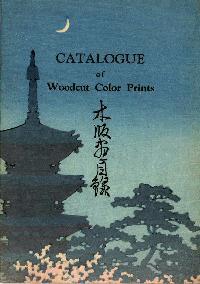
This is apparently the first bound catalog issued by the S. Watanabe Color Prints Company after World War II. Rarely found in the marketplace today, this 58-page volume is a streamlined, more focused version of the landmark 1936 catalog.
The following introduction by Watanabe is of interest to the serious shin hanga collector. It contains a few historical tidbits not discussed in other reference materials, and offers more direct insight into the marketing mind of this businessman and promoter.
In 1907, with a view to inspiring the traditional Japanese art of wood-engraving with a new life, we started producing medium and small-sized new color-prints for foreign connoisseurs. At the same time we compiled the "Mokuhan Ukiyoe Taika Gashû" (Book of Ukiyoe by Celebrated Artists) and the "Ukiyoe Hanga Kessaku-shû" (Collections of Masterpieces of Ukiyoe) to encourage the general love for this unique art at home.
Flattering ourselves that from this experience we had been able to grasp some of the spirit of the best old masters, we proceeded to study how really good modern color-prints could be created, with the help of several painters who were especially appreciative of our project. In this way, in 1915 we produced "Woman in the Bathroom" by Goyô Hashiguchi, in 1916 "Looking into the Mirror", an ambitious attempt by Shinsui Itô, then a young painter of unusual talent, and in 1918 and after landscape prints by Hasui Kawase. We were fortunate enough to enjoy a strong support of enthusiasts in Japan, and the future of new color-prints seemed highly promising.
Then a severe blow came in the form of the big Kantô earthquake of September 1, 1923, which destroyed the printing blocks and other materials as well as many finished color-prints, crippling the growth of this new art so relentlessly before it was yet out of the cradle. However, since skilled painters, engravers and printers all survived the catastrophe, we immediately made a fresh start, while unstinted patronage was accorded us by print-lovers both at home and abroad. Our effort was not fruitless, for nine years later, in April 1932, we were able to hold the first big exhibition after the earthquake at the art gallery of Shirokiya Department Store, Tokyo, where there was a josling crowd every day.
This favourable development continued until the outbreak of the World War II. During the war, materials went short, the artists dispersed and, worst of all, many of the printing blocks were reduced to ashes. However, that our shop itself escaped damage was our sole consolation. We re-started the work soon after the end of the war, and with the conviction that there is no boundary in the realm of art, hoped to contribute through color-prints to the promotion of goodwill and the reinforcement of cultural ties between nations. As this was only possible on a propitious footing, the first thing we did was to bring together our former staff who had been separated.
Now, after six years of post-war confusion, we have nearly completed our set-up to work on prints which will safely bear comparison with the pre-war products. We are determined to put our heart into every sheet of print, selecting materials all the more carefully, and studying the technique of engraving under the close care of painters. Nothing is more sincerely solicited at this juncture than your continued patronage and encouragement.
The present catalog contains all of our productions after the earthquake of 1923. Even those now out of print have been included, as the mere titles may serve as a record. Only the medium and small-sized prints have been excluded. Color-prints of high grade are prized better than original paintings and photographs for their sumptuous beauty of color, and are better suited as wedding gifts and lasting souvenirs. Their collection and connoisseurship is also an attractive hobby. We hope that this catalog for 1951 will be found useful both by collectors of prints and their dealers in making their selection.
December 1, 1951
SHÔZABURÔ WATANABE
| Return to top |
Update November 2000
Here's a citation from The new wave (Leiden: Hotei, 1993), in a discussion of Watanabe's postwar efforts:
And as to the suggestion that this catalogue's introduction is "the voice of Shôzaburô", we note with interest this footnote from the same source:
| Return to top |